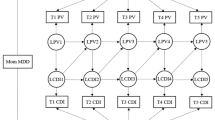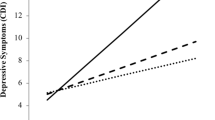Abstract
Although children of depressed mothers are at an increased risk for suicidal thinking, little is known about the potential mechanisms by which this occurs. The present study is the first to our knowledge to utilize a prospective design with the goal of examining whether the impact of maternal depression on children’s risk for suicidal ideation is mediated by children’s levels of overt and relational peer victimization. Participants were 203 mother-child pairs recruited from the community. The age range of the children was 8 to 14 years old (50.2 % girls). Mothers either met criteria for a major depressive disorder (MDD) during their child’s lifetime (n = 96) or had no lifetime diagnosis of any DSM-IV mood disorder and no current Axis I diagnosis (n = 107). At the baseline assessment, diagnostic interviews were used to assess mothers’ and children’s histories of MDD and children completed a self-report measure of peer victimization. Follow-up assessments were conducted at 6, 12, 18, and 24 months after the initial assessment during which time interviewers assessed for the occurrence of suicidal ideation in the children. Utilizing a mediated moderation model, we found significant indirect pathways from maternal depression to children’s suicidal ideation through both relational and overt forms of peer victimization among girls, but not among boys. The current study suggests that peer victimization may constitute one of the potential mechanisms by which daughters of depressed mothers are at increased risk for suicidal thinking.


Similar content being viewed by others
Notes
For the interested reader, we should note that mother MDD was significantly more strongly related to girls’ levels of relational victimization than overt victimization, z = 1.96, p = .025.
When both forms of peer victimization were entered into the model, neither was significant in predicting the emergence of suicidal thinking in children, suggesting that the effects were due to peer victimization generally rather than overt or relational victimization, specifically.
Details of these analyses are available from the first author.
References
Adrian, C., & Hammen, C. (1993). Stress exposure and stress generation in children of depressed mothers. Journal of Consulting and Clinical Psychology, 61, 354–359.
American Psychiatric Association. (2000). Diagnostic and statistical manual of mental disorders (4th ed., text rev.). Washington, DC: Author.
Carter, J. S., & Garber, J. (2011). Predictors of the first onset of a major depressive episode and changes in depressive symptoms across adolescence: stress and negative cognitions. Journal of Abnormal Psychology, 120, 779–796.
Centers for Disease Control and Prevention (2012). Web-based Injury Statistics Query and Reporting System (WISQARS) [Online]. (2003). National Center for Injury Prevention and Control, Centers for Disease Control and Prevention (producer). Available from: URL: www.cdc.gov/ncipc/wisqars. Accessed 28 Dec 2014.
Centers for Disease Control and Prevention (2013). Youth Risk Behavior Survey. Available at: www.cdc.gov/yrbs. Accessed 15 Jan 2015.
Crick, N. R., & Grotpeter, J. K. (1996). Children’s treatment by peers: victims of relational and overt aggression. Development and Psychopathology, 8, 367–380.
Crick, N. R., Casas, J. F., & Nelson, D. A. (2002). Toward a more comprehensive understanding of peer maltreatment: studies of relational victimization. Current Directions in Psychological Science, 11, 98–101.
Cummings, E. M., Keller, P. S., & Davies, P. T. (2005). Towards a family process model of maternal and paternal depressive symptoms: exploring multiple relations with child and family functioning. Journal of Child Psychology and Psychiatry, 46, 479–489.
Feurer, C., Hammen, C. L., & Gibb, B. (2015). Chronic and episodic stress in children of depressed mothers. Journal of Clinical Child and Adolescent Psychology. Advance online publication. doi: 10.1080/15374416.2014.963859.
First, M. B., Spitzer, R. L., Gibbon, M., & Williams, J. B. W. (1995). Structured clinical interview for Axis I DSM-IV disorders—Patient edition (SCID-I/P). New York: Biometrics Research Department, NY State Psychiatric Institute.
Gershon, A., Hayward, C., Schraedley-Desmond, P., Rudolph, K. D., Booster, G. D., & Gotlib, I. H. (2011). Life stress and first onset of psychiatric disorders in daughters of depressed mothers. Journal of Psychiatric Research, 45, 855–862.
Goodman, S. H., Rouse, M. H., Connell, A. M., Broth, M., Hall, C. M., & Heyward, D. (2011). Maternal depression and child psychopathology: a meta-analytic review. Clinical Child and Family Psychology Review, 14, 1–27.
Hammen, C., & Brennan, P. A. (2001). Depressed adolescents of depressed and nondepressed mothers: tests of an interpersonal impairment hypothesis. Journal of Consulting and Clinical Psychology, 69, 284–294.
Hankin, B. L., Mermelstein, R., & Roesch, L. (2007). Sex differences in adolescent depression: stress exposure and reactivity models. Child Development, 78, 279–295.
Hayes, A. F. (2013). Introduction to mediation, moderation, and conditional process analysis. New York: Guilford Press.
Heilbron, N., & Prinstein, M. J. (2010). Adolescent peer victimization, peer status, suicidal ideation, and nonsuicidal self-injury: examining concurrent and longitudinal associations. Merrill-Palmer Quarterly, 56, 388–419.
Kaufman, J., Birmaher, B., Brent, D., Rao, U., Flynn, C., Moreci, P., & Ryan, N. (1997). Schedule for affective disorders and schizophrenia for school-age children - present and lifetime version (K-SADS-PL): initial reliability and validity data. Journal of the American Academy of Child and Adolescent Psychiatry, 36, 980–988.
Kessler, R. C., Berglund, P., Borges, G., Nock, M., & Wang, P. S. (2005). Trends in suicide ideation, plans, gestures, and attempts in the United States, 1990–1992 to 2001–2003. Journal of the American Medical Association, 293, 2487–2495.
Kim, Y. S., Leventhal, B. L., Koh, Y. J., & Boyce, W. T. (2009). Bullying increased suicide risk: prospective study of Korean adolescents. Archives of Suicide Research, 13, 15–30.
Klimes-Dougan, B., Free, K., Ronsaville, D., Stilwell, J., Welsh, C. J., & Radke-Yarrow, M. (1999). Suicidal ideation and attempts: a longitudinal investigation of children of depressed and well mothers. Journal of American Academy of Child and Adolescent Psychiatry, 38, 651–659.
Klimes-Dougan, B., Lee, C., Ronsaville, D., & Martinez, P. (2008). Suicidal risk in young adult offspring of mothers with bipolar or major depressive disorder: a longitudinal family risk study. Journal of Clinical Psychology, 64, 531–540.
Klomek, A. B., Sourander, A., Kumpulainen, K., Piha, J., Tamminen, T., Moilanen, I., & Gould, M. S. (2008). Childhood bullying as a risk for later depression and suicidal ideation among Finnish males. Journal of Affective Disorders, 109, 47–55.
Klomek, A. B., Kleinman, M., Altschuler, E., Marocco, F., Amakawa, L., & Gould, M. S. (2011). High school bullying as a risk for later depression and suicidality. Suicide and Life Threatening Behaviors, 41, 501–516.
Monti, J. D., Rudolph, K. D., & Abaied, J. L. (2014). Contributions of maternal emotional functioning to socialization of coping. Journal of Social and Personal Relationships, 31, 247–269.
Silk, J. S., Shaw, D. S., Skuban, E. M., Oland, A. A., & Kovacs, M. (2006). Emotion regulation strategies in offspring of childhood-onset depressed mothers. Journal of Child Psychology and Psychiatry, 47, 69–78.
van Geel, M., Vedder, P., & Tanilon, J. (2014). Relationship between peer victimization, cyberbullying, and suicide in children and adolescents: a meta-analysis. JAMA Pediatrics, 168, 435–442.
Acknowledgments
The project was supported by National Institute of Child Health and Human Development grant HD057066 and National Institute of Mental Health grant MH098060 awarded to B. E. Gibb and the National Science Foundation Graduate Research Fellowship under Grant No. 1120674 awarded to A. Tsypes. Any opinion, findings, and conclusions or recommendations expressed in this material are those of the authors and do not necessarily reflect the views of the National Institutes of Health or the National Science Foundation.
We would like to thank Ashley Johnson, Lindsey Stone, Sydney Meadows, Michael Van Wie, Andrea Hanley, Katie Burkhouse, Mary Woody, Anastacia Kudinova, Effua Sosoo, Erik Funk, and Cope Feurer for their help in conducting assessments for this project.
Compliance with Ethical Standards
ᅟ
Ethical Approval
All procedures performed in studies involving human participants were in accordance with the ethical standards of the institutional and/or national research committee and with the 1964 Helsinki declaration and its later amendments or comparable ethical standards.
Informed Consent
Informed consent was obtained from all individual participants included in the study.
Conflict of Interest
The authors declare that they have no conflict of interest.
Author information
Authors and Affiliations
Corresponding author
Rights and permissions
About this article
Cite this article
Tsypes, A., Gibb, B.E. Peer Victimization Mediates the Impact of Maternal Depression on Risk for Suicidal Ideation in Girls but not Boys: A Prospective Study. J Abnorm Child Psychol 43, 1439–1445 (2015). https://doi.org/10.1007/s10802-015-0025-8
Published:
Issue Date:
DOI: https://doi.org/10.1007/s10802-015-0025-8




